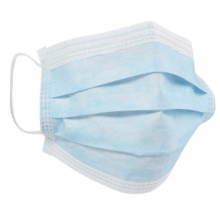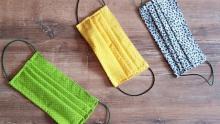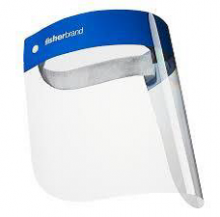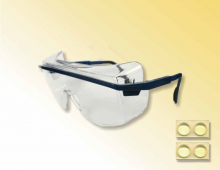Purpose
The purpose of this document is to distinguish the different types of personal protective equipment (PPE) and provide guidance with respect to their use as it pertains to commercial vehicle drivers.
These recommendations have been developed to complement the existing Federal safety guidance to protect drivers and limit the spread of COVID-19 in commercial vehicle operations and to respond to questions specifically relating to PPE and other cleaning supplies commercial vehicle drivers may need to ensure the Federal safety guidance can be respected. In addition to the federal safety guidance, commercial vehicle drivers and operators should follow advice and recommendations published by local and national public health authorities.
Ensuring Measures Taken to Protect Drivers Reflect Risk of Exposure
The optimal way to prevent airborne transmission is to apply a combination of controls from across the hierarchy of controls, not only PPE, in order to mitigate and/or eliminate hazards drivers and passengers may be exposed to. Commercial vehicle drivers and operators are encouraged to continue monitoring and abiding to public health authorities recommendations such as those published on the Government of Canada Coronavirus website.
As outlined in the Federal safety guidance to protect drivers, proven interventions to limit the spread of COVID-19 include: hand washing, regular cleaning of commonly touched surfaces, and respecting physical distancing by maintaining a 2 meter distance from other people. It is critical that these measures continue.
The federal Labour Program has posted general information to assist stakeholders in these responsibilities. Additional resources that may be of assistance include: the Government of Canada's Risk-informed decision making guidelines for workplaces and businesses during the COVID-19 pandemic and the Trucking HR Canada - COVID-19 Resource Guide for Trucking and Logistics Employers.
Masks/Face Coverings
N-95 Masks: In the context of the COVID-19 pandemic, respirators (e.g. N-95 masks) must be conserved for health care workers and others providing direct care to COVID-19 patients. An N-95 mask is a respirator which is required to be fitted to each wearer individually to ensure there is proper seal so that no contaminate can leak in from around the face – a process called fit testing. It is extremely important that the supply of this PPE not be diverted away from where it is needed most. As such, the use of respirators, outside of healthcare settings or other industries where respirators are routinely used, is not recommended.
Surgical Masks: Surgical masks are effective barriers for retaining large droplets which can be released from the wearer through talking, coughing, or sneezing. Surgical masks are typically used by medical professionals to avoid spreading germs to patients (e.g., during surgical or dental procedures).
At the same time, the filter material of surgical masks does not retain or filter out submicron particles, and therefore cannot be used as a protection from many hazardous airborne materials. In addition surgical masks are not designed to eliminate air leakage around the edges.
Face Covering: Wearing a non-medical mask or face covering is another way of covering your mouth and nose to prevent your respiratory droplets from contaminating others or landing on surfaces. A cloth mask or face covering can reduce the chance that others come into contact with respiratory droplets, in the same way that covering cough with tissues or the sleeve can reduce that chance. Instructions on how to make “sew” and “no-sew” cloth face coverings from t-shirt, bandanas, or other cotton-like materials are published on the Public Health Agency of Canada's about non-medical masks and face coverings page.
Transportation workers are encouraged to wear a non-medial mask or face covering:
- At any time when they cannot physically distance from others during the course of their duties;
- As directed by law enforcement, public health officials, Canada Border Service Agents, or other officials when crossing community check points, interprovincial borders, or the Canada-U.S. border (if required/as appropriate).
These masks or face coverings are not considered as PPE, however, training on the safe handling of these types of masks should be provided as these may become contaminated, which could infect the wearer or another person touching the mask.
In the context of the transportation sector, surgical masks offer a similar level of protection as other face coverings (see below) when physical distancing cannot be respected. Examples of the use of surgical masks within the transportation sector include commercial vehicle drivers, flight attendants and gate attendants.
Commercial vehicle drivers are therefore encouraged to wear a surgical mask, a non-medical mask or face covering:
- When they cannot physically distance from others;
- When they are required to exit their vehicle and may not be able to physically distance from others (e.g. at rest-stops, gas stations, during deliveries, etc.);
- As directed by law enforcement, public health officials, Canada Border Services Agency officers, or other officials when crossing community check points, interprovincial borders, or the Canada-U.S. border (if required/as appropriate).
Gloves
Disposable gloves (latex, vinyl, synthetic polymer or nitrile) are recommended when workers will be in direct contact with an ill person, or a contaminated object or environment. Gloves are not recommended when handling documents or providing services.
Commercial vehicle drivers are encouraged to use disposable gloves when cleaning high-touch surfaces in their vehicles. Caution and proper safety procedures for removing the gloves must be followed. An instructional video on how to properly remove gloves can be found here: https://www.canada.ca/en/public-health/services/video/covid-19-how-to-take-off-disposable-gloves.html. Soiled disposable gloves should be discarded in lined garbage receptacles, or stored in sealed disposable plastic bags until they can be properly disposed of if a garbage bin is not available.
Commercial vehicle drivers are also encouraged to wear gloves or otherwise cover their hands when pumping gas, touching the service station door handles, or handling any automotive products that may be required when performing vehicle maintenance, such as filling windshield washer fluid and adding motor oil, if possible. Commercial vehicle drivers should wash their hands or apply hand sanitizer immediately thereafter, if available.
Eye Protection
Eye protection, such as a face shield or goggles, is used to reduce exposure to splash, spray, or droplets from patients who are or may be infected. These are primarily used in healthcare settings by medical professionals who are assisting patients.
Within the transportation sector, PHAC is now advising that Canadian Air Transportation Security Authority (CATSA) screeners use eye protection in situations where they cannot maintain a two meter distance in the course of their duties and where a passenger cannot wear a mask or face covering (e.g. infant, respiratory condition).
|
Type of Mask |
Description |
Who Needs for COVID-19 |
|---|---|---|
|
N95 Respirator |
Used for working with dust, mold, or medical/environmental emergencies. Protects against airborne particles, but not gases or vapors. Protects healthcare workers from germs by blocking out at least 95% of small airborne particles (if worn, manipulated and disposed of correctly). |
Healthcare workers treating COVID-19 patients Transportation workers as recommended by OHS advice to protect from airborne particles (e.g. dust from grain, potash) Self-protection - yes Protect others – yes (except for models with an exhaust valve) |
|
Surgical Mask |
Used mostly by medical professionals to prevent them from getting germs on their patients. Can help protect wearers from getting others sick by preventing the spread of respiratory droplets. Does not protect healthy people from acquiring an illness and a loose fit leaves room for error. |
Transportation workers that are routinely required to have physical contact or be within 2 meters of others (e.g. CATSA screeners, flight attendants, truck drivers in “hot spots”). Sick people (to avoid infecting others) and caretakers Self-protection - yes (protection against droplets) Protect others – yes (protection against droplets) |
|
Non-Medical Mask/Face Covering |
Non-medical masks or face covering can be sewn, cut or fashioned from a bandana, t-shirt, or other breathable material. Can reduce the chance that others come into contact with respiratory droplets from the wearer. |
Transportation workers (e.g. Commercial Vehicle Drivers) that generally are able to respect physical distancing of 2 meters in performing duties. Self-protection - variable Protect others - yes |
|
Disposable Gloves |
Protect the wearer by providing a barrier to help prevent potential exposure to infectious disease. |
Healthcare workers treating COVID-19 patients Transportation workers that must come into physical contact with others or with potentially contaminated items Self-protection - yes Protect others – yes |
|
Face shield/Goggles |
Used by medical professionals as protection against droplets when working with patients. Shields fit over the face and are held in place by head straps or caps and cover the entirety of the face. Goggles for splash protection are worn over normal prescription eye glasses and contact lenses. |
Healthcare workers treating COVID-19 patients CATSA screeners that are unable to maintain two meters distance and where the passenger cannot wear a mask or face covering. The use of face shields/goggles is not currently recommended for commercial vehicle drivers. Self-protection - yes Protect others - no |
Hand Washing/Hand Sanitizer
Hand washing with plain soap and water is the preferred method of hand hygiene, since the mechanical action is effective in preventing the spread of COVID-19.
Hands should be washed using soap and warm water for at least 20 seconds. When drying hands, disposable paper towels are preferred.
If soap and water are not available, an alcohol-based hand sanitizer (ABHS) can be used as a temporary measure until hand washing can be done. ABHS containing 60-90% alcohol concentration (optimally over 70%) are the most rapidly active of all agents used in hand disinfection. However, ABHS may not be effective when there is organic material on your hands (e.g. after using the toilet). For this reason, ABHS alone should not be used on visibly soiled hands. Use wipes to remove soil, followed by ABHS.
Other Cleaning Supplies
Commercial vehicle drivers are encouraged to frequently clean high-touch surfaces in the cabs of their vehicles, especially at the start and end of each trip.
For routine cleaning and disinfection, and for areas potentially contaminated with COVID-19, a hard-surface disinfectant authorized by Health Canada is recommended. For a list of hard-surface disinfectants for use against coronavirus (COVID-19), please see Health Canada's website: https://www.canada.ca/en/health-canada/services/drugs-health-products/disinfectants/covid-19/list.html#tbl1
Commercial vehicle drivers will need cleaning cloths to disinfect high-touch surfaces using damp cleaning methods. Disposable cloths are preferred. After cleaning, soiled cleaning cloths should be disposed of in lined garbage bins, or stored in sealed disposable plastic bags until they can be properly disposed of if a garbage bin is not available. Reusable cleaning cloths may also be used, but should be stored in sealed disposable plastic bags until they can laundered using regular laundry soap and hot water (60 to 90 degrees Celsius). For additional information, please see: https://www.canada.ca/en/public-health/services/publications/diseases-conditions/cleaning-disinfecting-public-spaces.html





